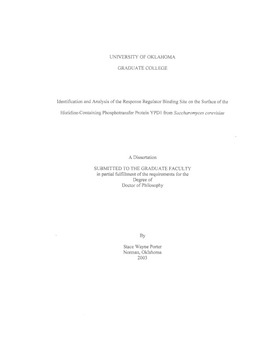| dc.contributor.advisor | West, Ann H., | en_US |
| dc.contributor.author | Porter, Stace Wayne. | en_US |
| dc.date.accessioned | 2013-08-16T12:19:09Z | |
| dc.date.available | 2013-08-16T12:19:09Z | |
| dc.date.issued | 2003 | en_US |
| dc.identifier.uri | https://hdl.handle.net/11244/661 | |
| dc.description.abstract | The results from the yeast two-hybrid screens were confirmed by the X-ray crystal structure of the SLN1-R1/YPD1 complex. This structure is the first to reveal protein-protein interactions between a monomeric HPt domain and a response regulator protein. Information gained in the study of response regulator interactions with YPD1 can be utilized to understand response regulator interactions with HPt proteins in other two-component pathways. | en_US |
| dc.description.abstract | Similar assays were performed that screened YPD1 mutants created in the above assay for interactions with the remaining two response regulator domains in S. cerevisiae, SLN1-R1 and SKN7-R3. Results from the screens showed that YPD1 uses the same general surface to bind each response regulator. In addition, residues on the surface of YPD1 in the binding interface were identified that could be involved in the discrimination between the three response regulator domains. Two locations on the surface of YPD1 were randomly mutated to each of the twenty amino acids in order to identify trends between the type of residue at the binding interface and the strength of interaction between YPD1-response regulator complexes. | en_US |
| dc.description.abstract | A histidine-containing phosphotransfer (HPt) protein, YPD1, plays a critical role in a multi-step phosphorelay signal transduction pathway in the yeast Saccharomyces cerevisiae. The SLN1-YPD1-SSK1 pathway controls activation of a downstream mitogen-activated protein (MAP) kinase in response to hyperosmotic stress. YPD1 is also involved in phosphoryl transfer in the SLN1-YPD1-SKN7 pathway involved in mediating cellular responses to cell wall damage and oxidative stress. It is known that YPD1 can interact with and transfer a phosphoryl group between the three response regulator domains (SLN1-R1, SSK1-R2 and SKN7-R3), however it is unknown how YPD1 distinguishes and interacts with the response regulators in order to elicit the correct response. Studies aimed at identifying a response regulator binding site as well as those aimed at addressing the question of specificity were initiated. | en_US |
| dc.description.abstract | In order to identify a response regulator binding site on the surface of YPD1, studies were conducted that coupled alanine-scanning mutagenesis on the surface of YPD1 and a yeast two-hybrid screen with the response regulator domain of SSK1. Mapping the results of the yeast two-hybrid screen onto the surface of YPD1 revealed a response regulator binding site between the site of phosphorylation, H64, and the alphaA helix of YPD1. Furthermore, the surface of YPD1 used to bind the response regulator domain of SSK1 consists of a hydrophobic patch surrounded by polar and charged residues. Alignment of the sequence of YPD1 with other monomeric HPt proteins revealed conservation of the hydrophobic patch on the surface of other HPt proteins. | en_US |
| dc.format.extent | xii, 116 leaves : | en_US |
| dc.subject | Chemistry, Biochemistry. | en_US |
| dc.subject | Saccharomyces cerevisiae. | en_US |
| dc.subject | Phosphotransferases. | en_US |
| dc.subject | Cellular signal transduction. | en_US |
| dc.title | Identification and analysis of the response regulator binding site on the surface of the histidine-containing phosphotransfer protein YPD1 from Saccharomyces cerevisiae. | en_US |
| dc.type | Thesis | en_US |
| dc.thesis.degree | Ph.D. | en_US |
| dc.thesis.degreeDiscipline | Department of Chemistry and Biochemistry | en_US |
| dc.note | Source: Dissertation Abstracts International, Volume: 64-10, Section: B, page: 4922. | en_US |
| dc.note | Adviser: Ann H. West. | en_US |
| ou.identifier | (UMI)AAI3109056 | en_US |
| ou.group | College of Arts and Sciences::Department of Chemistry and Biochemistry | |
